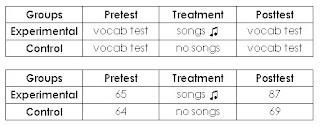1. Descriptive statistics: to describe numerical information about a particular group
e.g. You get data in the form of scores from the Writing class you’re teaching. You compute the mean of the scores to describe the students’ writing ability in average.
2. Inferential statistics: to describe numerical information about a particular sample and make inferences about the population.
e.g. You want to know the English proficiency of all students in a school. You draw a sample (50 students) and give an English test to the sample. After computing the mean, you make inferences about the English proficiency of all students (the population) from the results of the test of the sample.
1. Descriptive research
Survey: to get information about a population from the sample.
e.g. You want to know the English proficiency of all students (the population) in a school, but you investigate only some students (the sample).
Census: to get information about a population from all of the members of this population.
e.g. You want to know the English proficiency of all students in a school and include all of them in the study.
Longitudinal study: to find out the development of the research subjects by investigating a particular group from year to year.
e.g. You want to know the development of vocabulary size of students aged 11 to 15 years old. To investigate their development, you have 30 students who are 11 years old. Every year you give them a vocabulary test to measure their vocabulary size. This study is carried out for 4 years.
Cross-sectional study: to find out the development of research subjects by investigating people of different ages at one time.
e.g. You want to know the development of vocabulary size of students aged 11 to 15 years old. To investigate their development, you have 30 students who are 11 years old, 30 students who are 12 years old, 30 students who are 13 years old, 30 students who are 14 years old, and 30 students who are 15 years old. You give them all a vocabulary test to measure their vocabulary size on the same day.
Correlational study: to find out the relationship between 2 variables.
e.g. You want to know whether there is a relationship between the students’ writing ability and grammar competence. In other words, you’re wondering if students who have good grammar competence tend to have better writing ability. (Click here to learn more about correlation.)
2. Experimental research
You can read about the basic concepts of experimental research in my previous post below. Click here if you cannot find this post.
There are several things you need to remember about experimental research.
a. Experimental research does not try to find out correlation or relationship between two variables. Rather, it tries to find out the differences between two groups--or, to be precise, two means of the groups.
b. In experimental research, you can use compute t value for the results of both pretest and posttest, rather than postttest only. The t-test applied to these two types of tests has different purposes:
You compute t value of pretest scores in order to ensure that the experimental and control groups are equal before you give treatment. (If they are not equal, you should repeat the random sampling procedure).
You compute t value of posttest scores in order to find out whether the experimental and control groups are different after you give treatment.
3. Ex-post Facto research (coming soon)








